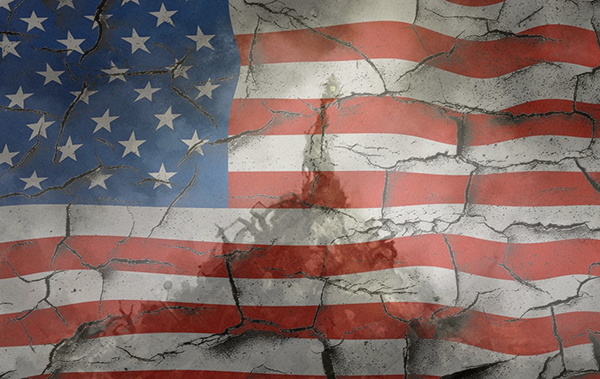Everything is Broken

In a recently highlighted post by Alana Newhouse on the Tablet website entitled Everything Is Broken the author generalizes from her experience with what she describes as a broken US medical establishment to musing on how every other part of modern American life appears broken as well. Newhouse uses the metaphors of ‘flattening’, ‘boundarylessness’, and ‘frictionlessness’ to describe how many aspects of our experience are being altered by rapid changes to our institutions and our relationships to them resulting in a sense that everything is broken. One finds in reading her description of current affairs a recognizable refrain repeated in the headlines. Her remedy for the pervasive brokenness is to attempt resisting being ‘flattened’, “Build new things! Create great art!…make a friend and don’t talk politics,…go back to a house of worship – every week”. Her diagnosis mostly focuses on the social and political institutions within which we live our lives, and which no longer seem to meet the needs of those they are intended to serve. In contrast, most of the material world Newhouse inhabits must be doing OK. There are no complaints about a car that won’t start or clocks that don’t keep time, and she appreciates the speed, accessibility, and portability of modern technology driven devices.
Thirty-two years ago Bob Dylan released a song entitled “Everything is Broken” . In Dylan’s song most of the items he mentions as broken are physical objects, “strings, springs, heads, beds, plates, gates, parts”, but then he comes to broken “hearts” which is followed by the line “broken words never meant to be spoken….everything is broken”. There is a medical condition called ‘broken heart syndrome’, but we know the poet is alluding to the metaphorical ‘broken heart’ of love’s thwarted desire and the words that typically spark the break. Also, among the non-material broken items in Dylan’s lyrics are “laws, treaties, vows, and rules”. Here we are in the arena of Newhouse’s broken world of human institutions. Our woke fellow citizens are familiar with the transgressive attitude towards laws, treaties and rules that they believe have repressed our desires and ensconced privilege for some and victimized others, usually historically marginalized groups. Breaking rules, even laws, that violate the rights or dignity of victims is celebrated by some. Breaking vows, however, resonate with other aspects of our frayed common life, marriage and faith. Whatever Dylan saw in the late 80’s that led him to include vows among the broken it has only become increasingly clear in the ensuing three decades, in spite of marriage itself having been inclusively redefined, that declining family formation and ecclesiastical scandals have exposed a brokenness at the core of these institutions.
“Everything is Broken” was one of ten songs on the album Oh Mercy whose title points to a source of healing for our brokenness. These other songs also are worthy of examination for insights into the poetic and prophetic path that Bob Dylan, along with the rest of Western culture, has traveled over the past thirty years:
- Political World
- Where Teardrops Fall
- Ring Them Bells
- Man in the Long Black Coat
- Most of the Time
- What Good Am I?
- Disease of Conceit
- What Was It You Wanted?
- Shooting Star
Gil Bailie has recently been sharing draft excerpts from his current manuscript project with friends of the Cornerstone Forum in monthly group Skype calls we’ve named ‘Florilegia’. The working title of the manuscript is “The Apocalypse of the Sovereign Self: Recovering the Christian Meaning of Personhood”. In an early section of the manuscript Gil discusses an experience which Bob Dylan relates in his 2017 Nobel Prize lecture in which a youthful Dylan, then Robert Zimmerman, attended a live performance of his idol Buddy Holly. That night Dylan indicates that he seemed to receive something from Holly in an uncanny way, and that the experience changed him. Shortly after this event Buddy Holly was killed in an airplane crash and Dylan was on a new path.
It could perhaps be surmised that Buddy Holly’s death was a shock to his young acolyte and the late adolescent world of Bob Dylan’s small town was broken apart in the smashed ruins of Holly’s airplane. Everything was broken…nevertheless something essential had been passed on that when nurtured and followed faithfully for twenty years ultimately grew into a deepening spiritual expression of Christian conversion blended with Dylan’s Jewish heritage.
Newhouse’s experience with the American medical establishment led her to see its brokenness and feel its failures personally. As a journalist her instincts directed her to search for the sources of the failures and expose them. It is another example of the perennial Western desire to shine a light on those who have been victims of any kind of injustice or suffering. However, someone who has recently recuperated from the suffocating effects of the COVID-19 virus after a long stay in the ICU, or who has lived many years after a successful cancer therapy would likely have a different opinion.
Modern Western medical institutions were developed over centuries by people who have gone from greater to lesser ignorance in understanding our physical and psychic ailments. In this undertaking they have learned how to alleviate or even cure various pathologies afflicting our species. And in the process, some of the hypotheses that have been put forth and the treatments developed from them have been found to be faulty with harmful results. Ultimately, these dead ends are abandoned, and new research is undertaken to find better more effective treatments with many more trials and errors. This lack of comprehensive knowledge is only one hinderance, and not the most debilitating one, to our institutions whether medical or any other kind.
Every person involved in the cultural endeavor is afflicted by what our Western tradition understands as a fallen human nature, the ‘disease of conceit’ in Dylan’s terms. In order to moderate the effects of this on our institutions we have tried in sometimes fumbling and half-hearted ways, so characteristic of our fallen human species, to restrain vices and encourage virtues. But human recalcitrance is immediately observed in objecting to ‘being told what to do’. This has led to cycles of casting off habits and doctrines inculcated by our Judeo-Christian tradition, and revivals of religious repentance and zeal with renewed dedication to teachings and ways of life which were understood as fundamental by many of those who founded this country and were trailblazers in the formation of its institutions. Nevertheless, since the enlightenment there has been a concerted movement away from the traditional religious basis of cultural values toward an increasingly secularized and materialistic world with an accompanying relativizing moral perspective.
Newhouse points to a period beginning in the latter half of the 20th century when many institutions were hollowed out by a corrosive mix of political, economic, and social policies. While this may be so, it reveals a predisposition to view the problems as essentially manageable. This attitude shows a determined avoidance of looking into the mirror our tradition holds up to each of us reflecting our self-delusion resulting from our fallen nature and sinfulness. Such interiority and self-reflection help provide a check on the pride and greed endemic in the Western enterprise. Perhaps we can make better policies, but who or what will make us better?
Of late the human problem of sin has become taboo. A sinful human nature has been eclipsed by a belief in a merciless human perfectibility. This belief is no less a religious attitude than the belief in the Fall, and with much less evidence to support it. Humans, usurping the place of God, are now the deity and science our sacred source of all that is known. It is now shameful to hold such retrograde ideas as a sinful human nature. Anyone who continues to hold onto such superstitious beliefs is considered anti-human and cancelled/silenced. The arbiters of culture seem to be saying, “It is a sin to believe in sin. Mercy is unacceptable and only weakens the race. It is better to cull the defective”.
It should not be surprising that our human institutions reflect this brokenness especially as the culture of which they are a part becomes evermore materialistic. Add to this that the entire world has been living in a pandemic reality for almost a year. In such circumstances we can see from past historical accounts (Boccaccio’s Decameron) a pervasive sense of anxiety induced by spreading disease and potential death can lead to a general societal breakdown, persecution, and violence. Recent events show we are not immune to such effects as well. This pandemic coming in the midst of the rancorous political atmosphere of the 2020 presidential election heightened the general uneasiness we all are feeling. With new variants of the virus reportedly spreading around the world who can say for sure when we will ever again feel as complacent about our contacts with others as we did in January 2020.
I sense there is a kind of misapprehension in the ‘everything is broken’ refrain. While Newhouse’s description of our situation sounds right, it is not the number of broken ‘things’ that is the essential issue. In whatever humans attempt to achieve there will always be broken aspects of it resulting from our fallen nature. It is both wisdom and humility that takes this into account.
As in the Greek aphorism, “The fox knows many things – The hedgehog knows one big thing”, Newhouse sees many broken institutions afflicting our polity, but she may be missing the one big thing that will provide context and meaning to the scene she describes. It is the one essential thing those like the hedgehog know, or perhaps more accurately experience, as the sacramental reality of forgiveness for sin – mercy. For the brokenness revealed in suffering, pain, or injustice will always provoke some kind of response. Newhouse advises a self-assertive resistance to ‘flattening’ and believes in this way we can overcome our current crisis of brokenness. There is precedent for this. Cultures can experience revivals when the divisions and resentments of the past are healed with the balm of mercy. But there is also precedent for institutional and cultural collapse in catastrophe and chaos. We do not know amid a crisis which it might be. The martyrs who, while forgiving and praying for those responsible for their suffering, also resist ‘flattening’ at the extremity and in so doing bear witness to a faith and hope that finds solace without resentment in the gift of mercy.

